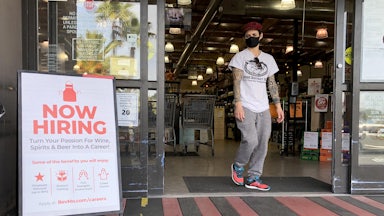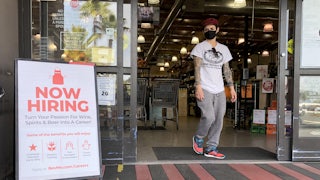How do you like the Great American Labor Shortage so far? Wages are rising faster than they have in nearly 40 years, reports Business Insider, excluding a freakish momentary spike last year when Covid-19 lockdowns began. The number of job openings (9.3 million) and the number of people quitting their jobs (4 million, or 2.7 percent) are higher than we’ve seen in 20 years. Prices, meanwhile, are up 5 percent over May 2020, the fastest rise in the Consumer Price Index in 13 years. When you exclude volatile food and energy prices, The New York Times reports, prices are rising faster than they have in almost 30 years.
The Wall Street Journal editorial page, from which I have borrowed the phrase “Great American Labor Shortage,” is practically suicidal, while The New York Times is heralding an imminent dictatorship of the proletariat. “Workers Are Gaining Leverage Over Employers Right Before Our Eyes” was the headline last week on the Times’ front page. The paper’s Neil Irwin conceded that the jump in wages and job vacancies “reflects a strange moment” in which the economy is reopening faster than workers are returning to work. But “the shift builds on changes already underway in the tight labor market preceding the pandemic,” as demographic trends shrank the pool of available workers. Karen Fichuk, chief executive of the staffing company Randstad North America, told Irwin that we’re witnessing “a historic moment for the American labor force.”
We are not witnessing a historic moment for the American labor force. We aren’t even witnessing a genuine labor shortage like the one we saw at the peak of the tech boom during the late 1990s. We’re seeing a momentary respite from the ghastly long-term shift of national income from labor to capital that (according to those Bolsheviks at McKinsey and Co.) has been increasing especially fast since 2000.
Nothing that happens during a nationwide pandemic, even as it’s winding down, follows normal rules. Economic recovery from the Covid lockdown will taper off next year as it becomes a distant memory. (I don’t intend to remember very much about this pandemic; do you?) The current mismatch between job openings and available workers will likely end sooner than that. Indeed, if enhanced unemployment insurance benefits are finally doing what Republicans claimed, incorrectly, they were doing all along—keeping unemployed workers from returning to work—then come fall, when they expire, you may be reading Page One stories about a labor surplus killing off wage growth.
The evidence throughout the pandemic has shown that enhanced unemployment benefits—a $600 add-on to weekly benefits, followed by six months of no add-on, followed by a $300 add-on that expires in early September—did not depress employment to any significant degree. A much-cited University of Chicago study concluded that the small disincentive created by the U.I. benefit expansion was outweighed by the economic stimulus created by the spending of that benefit, creating a net increase in employment. As recently as May 28, a paper by economists at the Federal Reserve Bank of San Francisco said the disincentive effect of the $600 and $300 add-ons was “small.”
There’s still no empirical evidence that these circumstances have changed. But increasingly, economists think the $300 work disincentive has lately become significant. Too many employers are going begging right now, and alternative explanations are in short supply.
For a long time it seemed likely that remote or “hybrid” schooling for young children was keeping mothers from returning to work, but a persuasive May study by Harvard’s Jason Furman and Wilson Powell III, and the University of Maryland’s Melissa Kearney, said that wasn’t the case. Rather, they found that during the pandemic, parents of young children left the workforce at about the same rate as other groups. Georgetown economist Harry Holzer points out that the study didn’t look at workers caring for elderly parents; still, that would be a much smaller group.
It’s very likely that some significant proportion of the unemployed aren’t returning to work because it still doesn’t feel safe. A May survey sponsored by the National Retail Federation found 35 percent of respondents said they wouldn’t feel comfortable returning to work unless they knew their co-workers were vaccinated. A census survey taken in March showed that the number of people not working for fear of contracting Covid-19, though declining, was a still significant 4.2 million.
Yet the Biden administration announced this week that, with the exception of hospitals, clinics, and doctors’ offices, workplaces will not have to follow the emergency temporary Covid standard that then-candidate Joe Biden excoriated Donald Trump for not imposing. It’ll be up to employers to compel returning workers to get vaccinated and/or wear masks. And although an April survey by the Rockefeller Foundation found that 60 percent of employers planned to require returning workers to show proof of vaccination, that means 40 percent of employers will not. The employers that don’t will likely be mostly in low-wage industries, where the perceived labor shortage is concentrated.
Josh Bivens of the left-leaning Economic Policy Institute has floated an interesting hypothesis that wages might not be accelerating as quickly as we think. May’s wage growth was driven by the leisure and hospitality sector, which consists mostly of workers at restaurants that customers are only just starting to patronize again. What if that wage surge, Bivens posits, is really a tip surge? This sector reported a huge decline in wages in March and April 2020 as restaurants were shutting down, even as other sectors were experiencing that freakish momentary wage spike at the start of the pandemic.
What’s different about restaurants? Well, Bivens observes, restaurant workers get tips, and when customers disappear, tips disappear. Now customers are coming back, along with tips.
Ultimately, it doesn’t matter what explanation you favor for the sudden mismatch between available jobs and willing workers, or for the recent spike in wages. The conditions that created these things are temporary. Writing in The New York Times, Dan Alpert, managing partner at Westwood Capital and adjunct professor at Cornell Law School, expressed worry not about a labor shortage but about an imminent labor surplus, particularly in low-wage jobs. As unemployment benefits dry up, Alpert said, there’s a decent chance “there won’t be enough jobs for the people eventually looking for work because so many businesses closed during the pandemic” (especially the small ones where low-wage workers typically work).
As for wages, yes, the aging of America is shrinking the pool of available workers. It remains to be seen whether Trumpian opposition to immigration will continue to dominate the GOP. But I have a hard time imagining Republican legislators will keep the spigot closed if wage pressures cause employers to howl in pain.
I doubt wage pressures will rise even that high. That’s because of a largely overlooked factor: the rise of the crap job. Even as the U.S. worker pool shrinks, the quality of available jobs will likely diminish, as it has now for decades. Alpert helped create a very useful economic indicator called the Job Quality Index to trace the displacement over time of good jobs by crap jobs (as measured by pay). In effect, Alpert argues, crap jobs are becoming the norm. Policymakers and corporations (over whom banks hold the whip hand far more than during most of the twentieth century) prefer it that way.
Why have wages stagnated during the past four decades? The EPI’s Bivens and Lawrence Mishel argued last month that the blame rests with high interest rates, proliferating trade deals, ever-more-brazen wage theft (i.e., employers’ failure to pay minimum wage or overtime), an eroding legal minimum wage, diminishing legal overtime eligibility, judicial decisions restricting the ability of workers to sue their employers, deregulation, privatization, economic concentration, a fissuring workforce (meaning a trend toward outsourcing labor within the U.S. to smaller, less scrupulous companies), and declining union power. These were policies consciously pursued by government at all levels at the behest of the business lobby.
I’m inclined to believe that the decline of union power—that is, the shrinking proportion of private-sector workers who belong to unions, amid steep government barriers to union organizing—is the linchpin. Ultimately, it all comes down to the exercise of power, and workers just don’t have any. That won’t change until the labor movement is rebuilt. The House-passed Protecting the Right to Organize Act would be a good start, but nobody expects it to pass anytime soon. It is therefore a childish fantasy to presume the American worker is gaining any real leverage over employers. Management has little to fear.








